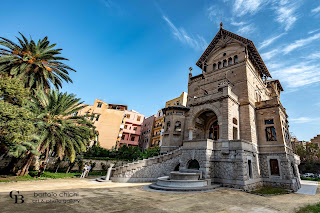Le bellezze dei Borghi - The Beauty of the Villages : Cefalù
Cefalù is located on the northern coast of Sicily, about 70 km from Palermo, at the base of a rocky promontory. It is one of the largest seaside villages in the whole region; despite its small size, every year it attracts a significant flow of local, national and foreign tourists, who in the summer period triple the population, making the most important squares and streets of the village very crowded.
Its name Kephaloidion is Greek and means "head", or "extremity" or "tip", to mean the promontory, the fortress. The Romans called it Coephaledium, while for the Arabs it was Gafludi, a fortified city rich in water.
Cefalù is part of the Madonie Natural Park, which includes 15 municipalities, we recommend you to visit Castelbuono and Pollina. The Madonie area is second for altitude only to Etna, reaching 1979 mt with Pizzo Carbonara. It is rich not only in castles and art but also in wildlife and botanical species.Its gastronomic tradition is extraordinary, full of flavors and genuine products, some of which have received internationally recognized quality certifications: DOP oil, DOC wine, pasta from the "granary of Sicily", typical cheeses, quality meat from animals bred in the pastures of Madonie, various pastry specialties. Finally, the typical handicraft offers ceramics, beautiful macramè hems, iron, wood and stone working.
According to legend, the cathedral of Cefalù was built following the vow made to the Most Holy Saviour by Roger II, who escaped a storm and landed on the beaches of the town. The real motivation seems rather of political-military nature, given its character of fortress.
The cathedral of the city is included in the Arab-Norman route together with Palermo and with the cathedral of Monreale, that on July 3, 2015 were declared a World Heritage Site by UNESCO.
Cefalù has the scent of the sea, and from the sea originates most of the typical dishes. But the queen of Cefalù cuisine is meat-based: pasta 'a taianu (pasta in a pan) is a delicious and poetic miscellany of flavors and fragrances, and main dish of the Feast of the Holy Saviour. The pasta is seasoned with ragù meat sauce, meat and fried eggplants.
The hill is full of olive trees overhanging the water, fertile districts rich in vineyards and orchards, and a promontory overlooking beaches, stacks and small gulfs along a coast marked by pine trees. It is within such an enchanting scenery that the "product" of Cefalù should be sought. The attention must also be paid to the daily ceremony of fishing in the open sea. The most common
types of fishing are "seine" (for juvenile sardines) and "three-stitches" (for blue fish).
Cefalù è situato sulla costa settentrionale della Sicilia, a circa 70 km da Palermo, alla base di un promontorio roccioso. E’ uno dei maggiori villaggi di mare di tutta la regione; nonostante le sue piccole dimensioni, ogni anno attrae un rilevante flusso di turisti locali, nazionali ed esteri, che nel periodo estivo triplicano la popolazione, rendendo molto affollate le piazze e le strade più importanti del villaggio.
Il suo nome Kephaloidion è greco e significa “testa”, oppure “estremità” o “punta”, per intendere il promontorio, la rocca. I Romani la chiamarono Coephaledium, mentre per gli Arabi era Gafludi, città fortificata e ricca di acque.
Cefalù fa parte del Parco Naturale delle Madonie, che comprende 15 comuni, vi raccomandiamo di visitare Castelbuono e Pollina. L’area delle Madonie è seconda per altitudine solo all’Etna, raggiungendo i 1979 mt col Pizzo Carbonara. è ricca non solo di castelli e arte ma anche di specie faunistiche e botaniche. La sua tradizione gastronomica è straordinaria, piena di sapori e prodotti genuini, alcuni di questi hanno ricevuto certificazioni di qualità riconosciute internazionalmente: olio Dop, vino Doc, pasta del “granaio di Sicilia”, formaggi tipici, carni di qualità da animali allevati nei pascoli madoniti, diverse specialità di pasticceria. Infine, l’artigianato tipico offre ceramiche, belle orlature in macramè, lavorazioni del ferro, del legno e della pietra.
Secondo la leggenda, il duomo di Cefalù sarebbe sorto in seguito al voto fatto al Santissimo Salvatore da Ruggero II, scampato ad una tempesta e approdato sulle spiagge della cittadina. La vera motivazione sembra piuttosto di natura politico-militare, dato il suo carattere di fortezza.
Il duomo della città è incluso nel percorso arabo-normanna insieme a Palermo e alle cattedrali di Cefalù e Monreale che, il 3 luglio 2015, sono state dichiarate Patrimonio dell’Umanitа dall’Unesco.
Cefalù ha il profumo del mare, e dal mare arrivano gran parte dei piatti tipici. Ma la regina della cucina cefaludese è a base di carne: la pasta ’a taianu (pasta al tegame) è una golosa e poetica miscellanea di sapori e profumi, e piatto forte della Festa del SS. Salvatore. La pasta è condita con ragù, carne e melanzane fritte.
La collina colma di ulivi a strapiombo sull’acqua, contrade fertili ricche di vigneti e frutteti, e un promontorio che guarda spiagge, faraglioni e piccoli golfi lungo una costa segnata da pini secolari. è all’interno di uno scenario così incantevole che va cercato il “prodotto” di Cefalù.
L’attenzione va posta anche sulla cerimonia quotidiana della pesca in mare aperto. Le tipologie di pesca più diffuse sono quella “a sciabica” (per il novellame di sarde) e “a tre maglie” (per il pesce azzurro).
Se volete, potete scaricare GRATUITAMENTE il terzo numero della nostra rivista "Sicily in Photo Magazine" al seguente link:
http://www.mediafire.com/file/8uaehvm3a9c9sgm/file




Commenti
Posta un commento